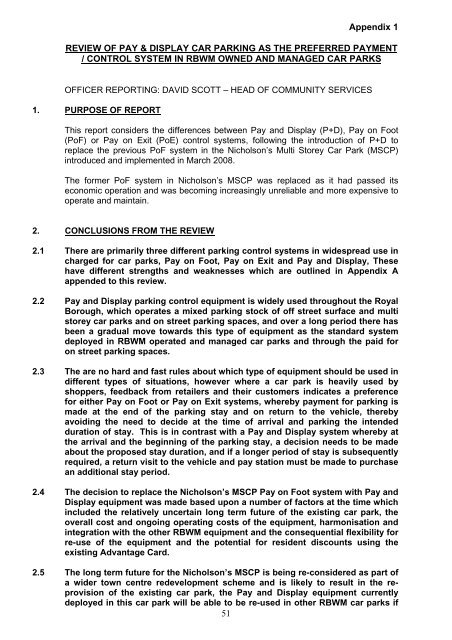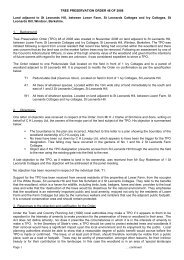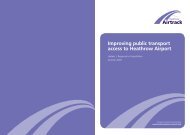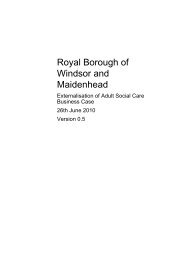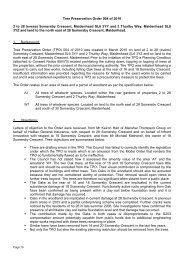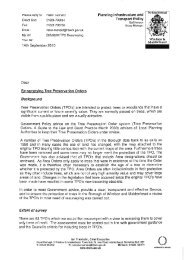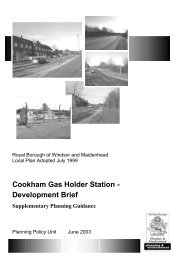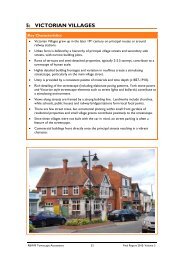Appendix 1 51 REVIEW OF PAY & DISPLAY CAR PARKING AS ...
Appendix 1 51 REVIEW OF PAY & DISPLAY CAR PARKING AS ...
Appendix 1 51 REVIEW OF PAY & DISPLAY CAR PARKING AS ...
You also want an ePaper? Increase the reach of your titles
YUMPU automatically turns print PDFs into web optimized ePapers that Google loves.
<strong>Appendix</strong> 1<br />
<strong>REVIEW</strong> <strong>OF</strong> <strong>PAY</strong> & <strong>DISPLAY</strong> <strong>CAR</strong> <strong>PARKING</strong> <strong>AS</strong> THE PREFERRED <strong>PAY</strong>MENT<br />
/ CONTROL SYSTEM IN RBWM OWNED AND MANAGED <strong>CAR</strong> PARKS<br />
<strong>OF</strong>FICER REPORTING: DAVID SCOTT – HEAD <strong>OF</strong> COMMUNITY SERVICES<br />
1. PURPOSE <strong>OF</strong> REPORT<br />
This report considers the differences between Pay and Display (P+D), Pay on Foot<br />
(PoF) or Pay on Exit (PoE) control systems, following the introduction of P+D to<br />
replace the previous PoF system in the Nicholson’s Multi Storey Car Park (MSCP)<br />
introduced and implemented in March 2008.<br />
The former PoF system in Nicholson’s MSCP was replaced as it had passed its<br />
economic operation and was becoming increasingly unreliable and more expensive to<br />
operate and maintain.<br />
2. CONCLUSIONS FROM THE <strong>REVIEW</strong><br />
2.1 There are primarily three different parking control systems in widespread use in<br />
charged for car parks, Pay on Foot, Pay on Exit and Pay and Display, These<br />
have different strengths and weaknesses which are outlined in <strong>Appendix</strong> A<br />
appended to this review.<br />
2.2 Pay and Display parking control equipment is widely used throughout the Royal<br />
Borough, which operates a mixed parking stock of off street surface and multi<br />
storey car parks and on street parking spaces, and over a long period there has<br />
been a gradual move towards this type of equipment as the standard system<br />
deployed in RBWM operated and managed car parks and through the paid for<br />
on street parking spaces.<br />
2.3 The are no hard and fast rules about which type of equipment should be used in<br />
different types of situations, however where a car park is heavily used by<br />
shoppers, feedback from retailers and their customers indicates a preference<br />
for either Pay on Foot or Pay on Exit systems, whereby payment for parking is<br />
made at the end of the parking stay and on return to the vehicle, thereby<br />
avoiding the need to decide at the time of arrival and parking the intended<br />
duration of stay. This is in contrast with a Pay and Display system whereby at<br />
the arrival and the beginning of the parking stay, a decision needs to be made<br />
about the proposed stay duration, and if a longer period of stay is subsequently<br />
required, a return visit to the vehicle and pay station must be made to purchase<br />
an additional stay period.<br />
2.4 The decision to replace the Nicholson’s MSCP Pay on Foot system with Pay and<br />
Display equipment was made based upon a number of factors at the time which<br />
included the relatively uncertain long term future of the existing car park, the<br />
overall cost and ongoing operating costs of the equipment, harmonisation and<br />
integration with the other RBWM equipment and the consequential flexibility for<br />
re-use of the equipment and the potential for resident discounts using the<br />
existing Advantage Card.<br />
2.5 The long term future for the Nicholson’s MSCP is being re-considered as part of<br />
a wider town centre redevelopment scheme and is likely to result in the reprovision<br />
of the existing car park, the Pay and Display equipment currently<br />
deployed in this car park will be able to be re-used in other RBWM car parks if<br />
<strong>51</strong>
<strong>Appendix</strong> 1<br />
an entirely new car park is built or the current one is extensively refurbished<br />
and it is proposed that a Pay on Foot or Pay on Exit system is the preferred<br />
solution.<br />
2.6 The cost to replace the former Pay on Foot system with a Pay and Display one<br />
was significantly less than a like for like replacement. In addition to the initial<br />
capital costs the ongoing operational equipment costs for the Pay and Display<br />
system are lower than those for a stand alone Pay on Foot or Pay on Exit<br />
system.<br />
3. SUPPORTING INFORMATION<br />
3.1 TERMS <strong>OF</strong> REFERENCE<br />
A Terms of Reference (ToR) for the review was prepared in early June following a<br />
request from the Leader of the Council for a review of parking controls systems.<br />
Subsequent to this request a Public Petition was received by Cllr Burbage which he<br />
presented to Council on 26 th June, signed by over 2760 shoppers, traders and town<br />
centre users which was co-ordinated by Richard Manders - Managing Director of Beds<br />
are Uzzz - a town centre based business.<br />
The Objectives of the Review were to:-<br />
• examine the Strength and Weakness of Pay and Display (P+D) and Pay on Foot<br />
(PoF) or Pay on Exit (PoE) operations.<br />
• examine and compare the types of parking systems in use in adjacent Towns and<br />
Boroughs.<br />
• examine examples of where changing from one type of system to another have<br />
been implemented and consider lessons learnt.<br />
• examine and review best practice.<br />
• achieve a strategic approach to parking policy and changes across on-street,<br />
surface and multi-storey car parks which is seen by users to support their needs,<br />
that of the local economy and recognising Council’s own budgetary needs.<br />
3.2 BACKGROUND<br />
3.3.1 Historically RBWM has operated and managed the Borough owned car parks through<br />
a mixed set of control equipment systems, including P+D, PoF, PoE. Over the last<br />
ten years all of the Borough’s MSCPs (Victoria Street, Stafferton Way, Hines Meadow<br />
and Nicholson’s have had their method of payment system changed from either PoF<br />
or PoE to P+D. These changes have taken place as existing equipment reached the<br />
end of its economic or effective working life and needed to be replaced to ensure a<br />
reliable and cost effective system was maintained. (Approximate dates of change over<br />
for the other sites are:- Victoria MSCP February/March 1998, Stafferton Way MSCP<br />
April 2002, Hines Meadow MSCP March 2005 (to coincide with the start of<br />
Sainsbury’s scheme). In addition Windsor Leisure Centre was changed from a mixed<br />
scenario which included P+D, PoE and PoF (a shared system) to a single P+D system<br />
in April 2000. Windsor Dials (public use at the weekends) was changed to P+D from<br />
PoE in early 2008 as the PoE equipment had passed its economic operation and was<br />
causing increasing problems for users and costs for RBWM.<br />
52
<strong>Appendix</strong> 1<br />
3.3.2 Systems have been changed to P+D over a long period of time but the Nicholson’s<br />
MSCP change in March 2008, was the last site to migrate to P+D. This has meant that<br />
the Borough now only has P+D systems and this single system approach helps with<br />
operational management, maintenance and support, running costs and flexibility of<br />
management keeping machines operational.<br />
3.3.3 The main and general Advantages and Disadvantages of the different control systems<br />
are compared in <strong>Appendix</strong> A. Different systems offer different benefits and there are<br />
no simple, hard and fast rules to use when deciding which system to adopt. Generally<br />
each site needs to be considered in its own right and the specific issues which each<br />
site has -to inform the selection made. Each system also has its own disadvantages.<br />
3.3.4 There are a number of specific reasons which are relevant to changes made to<br />
individual RBWM car parks:-<br />
At Victoria Street MSCP, P+D was identified as the preferred choice partly due to the<br />
size of the car park (206 spaces) and partly due to the congestion that was caused by<br />
vehicles queuing to exit as a result of the design and circulation routes within the car<br />
park, when this car park was a Pay on Foot system.<br />
In Stafferton Way MSCP a very high proportion of users (98%) are long term,<br />
generally all day parkers. To reflect this site’s location and intended use there are only<br />
2 tariffs available (one which provides for all day use and an off peak evening tariff<br />
after 7pm). P+D is therefore the simplest system to operate and use for this site.<br />
In Hines Meadow MSCP (which was refurbished as part of the Sainsbury’s<br />
redevelopment scheme) P+D was introduced as it enabled Sainsbury’s users to<br />
obtain a voucher for the refund of parking which the store wanted to offer its shoppers,<br />
and it also enabled the car park to be easily separated into long and short stay<br />
designated areas which operated different daily tariff rates. This was done to ensure<br />
short stay users only were parking close to the store entrances.<br />
Prior to the changes, Windsor LC operated a mixed set of systems in part as a legacy<br />
from its days as Windsor Leisure Pool, when the total available parking spaces was<br />
less, and the site was controlled so as to provide preferential rates for leisure users<br />
and discourage longer term town centre related use. As the site was extended and<br />
new facilities added, the car park was expanded, a simplified and single P+D method<br />
was adopted, whereby the tariff structure provided the controls to avoid long stay use,<br />
and refunds were offered to Leisure Centre users.<br />
3,4 Nicholson’s MSCP – Changes<br />
In Nicholson’s MSCP, P+D was introduced after a number of factors were considered.<br />
The key issues were:-<br />
a. Ticket Failures: Significant numbers (3 or 4 per week) of users became trapped in<br />
the car park in the late evening (when the car park is unmanned) due to the tickets<br />
collected on entry, becoming damaged and no longer being able to be read by the pay<br />
on foot machines (known as ‘read fail’ tickets). This resulted in customers having to<br />
call the Control Room so that a mobile team could be contacted to attend to release<br />
them. Customers were required to wait in the car park until the arrival of a member of<br />
staff, this could take up to 20 minutes. If the customer was trying to exit the car park<br />
after the mobile team have gone off duty, this call out could be longer as a standby<br />
‘duty officer’ would need to be mobilised, typically from home.<br />
b. Congestion Reduction: Traffic congestion results on the Broadway due to the time<br />
taken to enter and exit the car park. The current Broadway configuration of the one<br />
53
<strong>Appendix</strong> 1<br />
way street in relation to the entrance and exit of the car park, means that when the car<br />
park reaches capacity, or if entry becomes blocked (eg equipment failure) the traffic<br />
either trying to get into the car park and or down Broadway, quickly backs up to block<br />
the exit from the car park. This design means that car park users become log jammed<br />
in and this as well as the vehicles jammed in the Broadway contribute to the poor air<br />
quality in the area. (The Broadway is the centre for one of only two Air Quality<br />
Management Zones in RBWM). Speeding up the entry system (albeit there is still a<br />
barrier and count system in place) reduces the likelihood of the entry to the car park<br />
being a cause of the congestion, for most periods of the operation. The reduced<br />
congestion will positively help towards the improvement of overall Air Quality in the<br />
area.<br />
c. Advantage Opportunities: A very large proportion of users (approximately 75%<br />
historically) stay for less than 2 hours, therefore changing to P+D should have limited<br />
detrimental effect on these users, however it would have a potential beneficial effect in<br />
that it would become possible to offer the options to introduce a discounted tariff<br />
through the Advantage Card system (not previously possible through PoF system).<br />
Due to the very high number of Advantage Cards in circulation which operate with the<br />
existing P+D machines it was not considered viable to introduce an alternative<br />
‘resident card’ for operation in a different parking system.<br />
d. Future of the Car Park: At the time the equipment needed to be replaced, the long<br />
term future of the car park was uncertain, largely due to the age of the construction<br />
and the potential for redevelopment that had been muted in recent years, at that time<br />
in connection with the Nicholson Centre potential development plans (2006).<br />
The usage patterns in this car park were also considered as part of the decision, the<br />
vast majority of users falling into either short stay or long stay categories. The large<br />
majority of users being short stay parkers, either staying only up to one or two hours,<br />
or being season ticket holders (approx 5%) staying long term (all day) and associated<br />
with the nearby office or retail developments.<br />
e. The Only Non Pay and Display site: When the final decisions to proceed with<br />
replacement of the PoF system were taken consideration was given to the site being<br />
the only non Pay and Display site within the Borough operated and managed car park<br />
where charges apply.<br />
f. The cost of replacement equipment: The overall costs of replacing the PoF system<br />
was considered in terms of both the initial capital procurement and the ongoing<br />
revenue costs. The initial overall capital costs of a PoF system were higher than the<br />
overall costs for change over to P+D. In addition the ongoing revenue costs of adding<br />
a number of extra P+D machines to the existing maintenance and support contracts<br />
was lower that a stand alone contract specifically for a PoF system. There were also<br />
benefits in terms of flexibility by using more of the same machines rather than having<br />
to hold spares for a stand alone system. The overall cost of a P+D system was<br />
therefore lower than a PoF system. The estimated difference in capital cost at the time<br />
the options was being considered was £175K for PoF vs. £125K for the P+D option.<br />
In addition to these considerations, there was also considered to be a positive benefit<br />
from a change over to P+D that results from the increased frequency of patrols. The<br />
level of crime and the fear of crime are reduced as Parking Officers patrol the car<br />
parks more frequently, and resources are less tied to the exit area monitoring exit<br />
equipment.<br />
54
3.5 Other examples of parking systems in the local area<br />
55<br />
<strong>Appendix</strong> 1<br />
Whilst it is difficult to compare Maidenhead or Windsor directly to a specific other town<br />
in the local area, users of RBWM car parks do make comparisons with their shopping<br />
experiences elsewhere. In the surrounding area there are a number of towns which<br />
offer different shopping experiences and different parking control systems. There are<br />
no simple ‘rules of thumb’ about which sort of system is used in which sort of car park,<br />
however, generally there is a mixture of systems in use in many of the local towns.<br />
These are set out in <strong>Appendix</strong> C.<br />
If Multi Storey Car Parks only are considered there is a higher proportion of these car<br />
parks that use Pay on Foot or Pay on Exit systems, rather than Pay and Display. The<br />
Multi storey shoppers car parks tend to have PoE or PoF systems.<br />
A number of other Councils have considered changes to the method of payment<br />
system in their car parks. From the research undertaken in connection with this review<br />
it appears that Winchester City Council have recently discussed reverting a<br />
Winchester car park back to P+D following it being changed to PoF approximately five<br />
years ago. The Council’s main argument for reverting to P+D is that the PoF<br />
equipment is not as reliable as the P+D equipment used elsewhere, and that due to<br />
the design and location of the car parks considerable traffic congestion was caused.<br />
East Herts Council have recently been discussing whether their Bircherley Green car<br />
park should become PoF, however the Council’s consultants advised that due to the<br />
size and layout of the car park changing to PoF would be costly, would result in the<br />
loss of spaces as spaces would need to be lost, due to changes to the entry and exit<br />
lanes. As a result tariffs would require an increase if the income levels were to be<br />
sustained.<br />
3.6 The impact of changing to Pay and Display on usage<br />
During the first six months of operation in the period from the introduction of P+D in<br />
early March 2008, there has been little change in the profile of daily paying users. A<br />
summary analysis of parking stay lengths both before changing to P+D and after<br />
changing to P+D is shown in <strong>Appendix</strong> B.<br />
This usage indicates that although there has been considerable feedback to the<br />
Council about the change, the actual patterns of use have not changed significantly.<br />
The introduction of a revised tariff with effect from 15 th September, whereby a new ‘up<br />
to 4 hour’ charge has been set for £2 has been designed to offer users the opportunity<br />
to double their available parking time for only 50p or 40 p more than the up to 2 hour<br />
charge.<br />
4 Relevant National/Regional Guidance<br />
No national or regional guidance exists that could be considered to provide a guide to<br />
Best Practise. However the British Parking Association advises that Local Authorities<br />
should consider payment method options and decide the method that best suits the<br />
Local Authority’s and users requirements. They suggest a number of criteria that<br />
should be considered which include, enforcement methods, customer requirements,<br />
traffic flows, discounted parking requirements, and equipment costs.
<strong>Appendix</strong> A<br />
Comparisons – Pay on Foot, Pay on Exit and Pay and Display Systems<br />
Feature Pay on Foot (PoF) Pay on Exit (PoE) Pay and Display (P+D)<br />
Evasion of Payment All users will have to pay prior to exiting the<br />
car park.<br />
Revenue from Penalty and<br />
excess charges<br />
Customers having to return<br />
to vehicles at a set time<br />
No as customers only pay on return to<br />
vehicles when leaving<br />
Customers can stay as long as they wish<br />
(excluding any car park closing times that<br />
may exist).<br />
Traffic flow The entry and exit times at the car park are<br />
increased but are faster than Pay on Exit<br />
systems. Queues onto main roads can be a<br />
problem as a result of the slower entry rates<br />
at busy times, when the car park entry barrier<br />
is located close to the exit from the highway.<br />
Discounted parking by<br />
shops, theatre etc<br />
Potentially available by the use of validating<br />
device which would be leased from car park<br />
operators. Not all PoF Systems have remote<br />
validation options.<br />
Power failure Limited manual operation available due to the<br />
need for barriers to be operated in response<br />
to validated tickets, limited scope for battery<br />
operated back ups. Can result in possible<br />
revenue loss if power failures are over any<br />
Equipment failure or down<br />
time due to servicing<br />
length of time.<br />
A minimum 2 entry lane, 2 exit lane system<br />
with 2 or more pay stations will be able to<br />
operate, in the event equipments fails, albeit<br />
at limited capacity. There would be reduced<br />
traffic flow during the servicing or failure of a<br />
lane. A single entry/exit system is equipment<br />
critical at the entry and exit points, and not<br />
normally designed.<br />
All users will have to pay prior to exiting the car<br />
park.<br />
No as customers only pay on return to vehicles<br />
when leaving<br />
Customers can stay as long as they wish<br />
(excluding any car park closing times that may<br />
exist).<br />
The entry and exit times at the car park are<br />
increased. Queues can develop back onto<br />
main roads where entry barrier system is<br />
located close to the exit from the highway.<br />
Limited manual operation available due to the<br />
need for barriers to be operated in response to<br />
validated tickets, limited scope for battery<br />
operated back ups. Can result in possible<br />
revenue loss if power failures are over any<br />
length of time.<br />
A minimum 2 entry lane, 2 exit lane system<br />
with 2 or more pay stations will be able to<br />
operate, in the event equipments fails, albeit at<br />
limited capacity. There would be reduced<br />
traffic flow during the servicing or failure of a<br />
lane. A single entry/exit system is equipment<br />
critical at the entry and exit points, and not<br />
normally designed.<br />
56<br />
<strong>Appendix</strong> 1<br />
Customers could evade paying for their<br />
parking, but run the risk of receiving a PCN if<br />
caught. .<br />
Yes – if customers decide not to P+D, or over<br />
stay their paid time and the grace period<br />
allowed before PCN is issued.<br />
Customers have to return to their vehicles at a<br />
set time, which they must decide on at the time<br />
of parking and purchasing their ticket, or return<br />
to their vehicle to purchase additional parking<br />
time.<br />
There is no impediment of traffic flow at entry<br />
unless the car park becomes full. Numbers in<br />
the car park can be controlled by barriers<br />
operated on entry and exit counts, only slowing<br />
traffic when approaching capacity. Should<br />
reduce congestion on the highway due to<br />
faster entry arrangements.<br />
Reminder portion of the ticket could be used to<br />
provide a discount against parking costs.<br />
Latest machines will operate for approximately<br />
1-2 (or more) weeks on battery only. No<br />
revenue loss.<br />
Customers would have to use another pay<br />
station machine (provided more than one<br />
machine in the car park) and would therefore<br />
be inconvenienced, but still able to purchase<br />
ticket. Generally no impairment of traffic flow.
Feature Pay on Foot (PoF) Pay on Exit (PoE) Pay and Display (P+D)<br />
Staffing A member of staff is required to monitor the<br />
system and operate the customers ‘help’<br />
intercom. It is possible to operate the site<br />
remotely but problems can occur if an<br />
attendant is not on site within a few minutes.<br />
This is especially true at peak times.<br />
Convenience Provided the pay stations are positioned in<br />
suitable walkways, customers do not have to<br />
walk any additional distance en route back to<br />
vehicle. No requirement to make a repeat<br />
visit to their vehicle to extend display a ticket.<br />
Friendliness Customers do not receive penalty charges.<br />
Customers can be under pressure at the exit<br />
barrier if they are not able to offer or insert a<br />
valid ticket although modern system can<br />
incorporate credit card payment options via<br />
help function at exit point.<br />
Queues can quickly form if lanes become<br />
blocked.<br />
Security Thieves would have to bring a vehicle into<br />
the car park in order to obtain a parking card<br />
to exit with a stolen car, or pay lost card fee.<br />
Entry and exit points are excellent points to<br />
view a static vehicle driver with C.C.T.V.<br />
Change giving Yes – modern machines generally<br />
incorporate change givers in all pay stations.<br />
.<br />
Vandalism Barriers are susceptible to vandalism and<br />
accidental damage. Significant revenue loss<br />
may happen if pay equipment or barrier arms<br />
are damaged.<br />
Maintenance Cost Unless operators have their own<br />
maintenance staff the service costs for Pay<br />
on Foot system are often two or three times<br />
that for a Pay and Display car park. Out of<br />
hours, weekend cover is likely to be required.<br />
A member of staff is required to monitor the<br />
system and operate the customers ‘help’<br />
intercom. It is possible to operate the site<br />
remotely but problems can occur if an<br />
attendant is not on site within a few minutes.<br />
This is especially true at peak times.<br />
Payment made on exit from car park, means<br />
that no additional walking required to or from<br />
pay stations.<br />
Customers do not receive penalty charges.<br />
Customers can be under pressure at the exit<br />
barrier if they are not able to offer or insert a<br />
valid ticket. Some POE systems can include<br />
credit card payment so avoid need for cash.<br />
Queues can quickly form if exit lanes become<br />
blocked.<br />
Thieves would have to bring a vehicle into the<br />
car park in order to obtain a parking card to<br />
exit with a stolen car, or pay lost card fee.<br />
Entry and exit points are excellent points to<br />
view a static vehicle driver with C.C.T.V.<br />
Yes – modern machines generally incorporate<br />
change givers in all pay stations.<br />
Barriers are susceptible to vandalism and<br />
accidental damage. Significant revenue loss<br />
may happen if pay equipment or barrier arms<br />
are damaged.<br />
Unless operators have their own maintenance<br />
staff the service costs for Pay on Foot system<br />
are often higher than for a Pay and Display car<br />
park. Out of hours, weekend cover is likely to<br />
be required.<br />
57<br />
<strong>Appendix</strong> 1<br />
Provided the machine has tickets and the cash<br />
boxes are not full, the system could operate<br />
with the absence of staff. Effective<br />
patrol/enforcement is important but not<br />
essential in the short term to maintain<br />
revenues.<br />
Customers have to purchase their ticket and<br />
then return to their vehicle to display the ticket.<br />
Customers must decide at the time of parking<br />
how long they wish to park for and purchase<br />
that period within the prevailing tariff.<br />
Penalty charges are issued for over stays, and<br />
failure to P+D.<br />
Patrolling Enforcement Officers provide high<br />
profile reassurance to customers, and<br />
deterrent to criminal operators.<br />
Not built in to pay stations but separate change<br />
machines can be included to provide change<br />
options.<br />
Pay and Display machines can be attacked. If<br />
there is more than one machine in the car park<br />
then there is no reason for revenue loss unless<br />
there was a series of attacks.<br />
Generally lower maintenance cost. Attendants<br />
can rectify significant amount of faults. Car<br />
parks with more than one machine do not<br />
require weekend and out of hours cover.
<strong>Appendix</strong> B<br />
58<br />
<strong>Appendix</strong> 1<br />
up to 2 hours<br />
NICHOLSONS MSCP – Profile of Users<br />
Pre March 2008 Changes March – September 2008<br />
74.00% 77.00%<br />
up to 3 hours 13.00% 12.80%<br />
up to 4 hours 5.40% 4.20%<br />
up to 5 hours 1.50% 1.30%<br />
over 5 hours 5.40% 4.70%<br />
For comparison purposes the Hines Meadow MSCP use is shown below. The revised<br />
Hines Meadow MSCP opened on 15 th December 2007 when the Sainsbury’s<br />
redevelopment opened.<br />
Hines Meadow MSCP Profile of Users<br />
2008/09 to date 2007/08 2006/07<br />
up to 2 hours 76 75 67<br />
up to 3 hours 5 7 9<br />
up to 4 hours 1.5 2 4<br />
up to 5 hours 6.7<br />
over 5 hours 7 12<br />
Evening 9 9 8
<strong>Appendix</strong> C<br />
59<br />
<strong>Appendix</strong> 1<br />
Key Multi-Storey Car Parks - Summary of Payment Systems used in adjacent<br />
towns<br />
Reading<br />
Broad Street Mall – Pay on Foot<br />
Oracle - Pay on Foot<br />
Queens Road – Pay on Foot<br />
Civic Centre – Pay and Display<br />
Chatham Place – Pay on Exit<br />
High Wycombe<br />
Easton Street – Pay on Foot<br />
Wycombe Swan – Pay and Display<br />
Staines<br />
Elmsleigh MSCP and Surface Car Park – Pay on Foot<br />
Tothill MSCP – Pay and Display<br />
Bracknell<br />
Princess Square – Pay on Foot<br />
Charles Square – Pay on Exit<br />
High Street MSCP – Pay on Exit<br />
Slough<br />
Brunel Car Park – Pay and Display<br />
Herschel Multi Storey – Pay and Display<br />
Hatfield Multi Storey – Pay and Display<br />
Observatory (private) – Pay on Foot<br />
Queensmere (private) – Pay on Foot<br />
Wokingham<br />
No MSCPs all surface car parks operate Pay and Display System<br />
Background Papers:<br />
Terms of Reference<br />
Report to September Cabinet 2008 in response to Petition received


